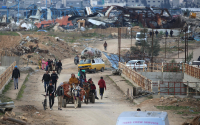24 August 2006Planet ArkJim Loney
Max Mayfield, director of the US National Hurricane Center, says there's plenty of potential for a storm worse than Hurricane Katrina which killed 1,339 people along the US Gulf coast and caused some US$80 billion in damage last August.
"People think we have seen the worst. We haven't," Mayfield told Reuters in an interview at the fortress-like hurricane centre in Florida.
"I think the day is coming. I think eventually we're going to have a very powerful hurricane in a major metropolitan area worse than what we saw in Katrina and it's going to be a mega-disaster. With lots of lost lives," Mayfield said.
"I don't know whether that's going to be this year or five years from now or a hundred years from now. But as long as we continue to develop the coastline like we are, we're setting up for disaster."
Looking back nearly a year to the costliest natural disaster in US history, and the third-worst hurricane in terms of American lives lost, Mayfield said Katrina itself could have been a greater disaster.
By Friday night, more than two days before the storm struck the Gulf coast on Aug. 29, the hurricane centre had predicted its future track accurately and also warned it could become a powerful Category 4 storm on the five-step Saffir Simpson scale of hurricane intensity.
New Orleans was squarely in the danger zone, and emergency managers and residents had plenty of time to prepare.
"One of my greatest fears is having people go to bed at night prepared for a Category 1 and waking up to a Katrina or Andrew. One of these days, that's going to happen," Mayfield said.
Katrina went just to the east of New Orleans, sparing the city the worst of a massive storm surge and the strongest winds. But still the city's protective levees failed.
VULNERABLE CITIES
The worst-case hurricane scenario? Mayfield has many in mind. A stronger hurricane closer to New Orleans. A direct hit on the vulnerable Galveston-Houston area, the fragile Florida Keys or heavily populated Miami-Fort Lauderdale.
Or how about a major hurricane racing up the east coast to the New York-New Jersey area, with its millions of people and billions of dollars of pricey real estate?
"One of the highest storm surges possible anywhere in the country is where Long Island juts out at nearly right angles to the New Jersey coast. They could get 25 to 30 feet (7.6 to 9.1 metres) of storm surge ... even going up the Hudson River," Mayfield said.
"The subways are going to flood. Some people might think 'Hey, I'll go into the subways and I'll be safe.' No, they are going to flood."
Mayfield, a silver-haired, 34-year veteran of the hurricane centre who became its public face in 2000, is a tireless campaigner for hurricane preparation, warning the 50 million people who live in US coastal counties from Maine to Texas that they are all in the path of a future storm.
He is mystified by a study that found 60 percent of people in hurricane-prone US coastal areas have no hurricane plan -- which to disaster managers means up to a week's worth of food and water squirreled away, a kit with flashlights and other gear and an established evacuation route to higher ground.
"After Katrina and after the last two hurricane seasons you can't understand why more people are not taking hurricanes seriously," Mayfield said.
Katrina, he says, killed people who stayed in their homes with confidence because they had lived through 1969's Hurricane Camille. Camille was a much stronger storm than Katrina when it crashed ashore in Louisiana and Mississippi as one of only three Category 5s to hit the United States in recorded history.
"There were a lot of people who lost their lives because they thought that they had already lived through the worst they could possibly live through," Mayfield said.
"Experience isn't always a good teacher."






